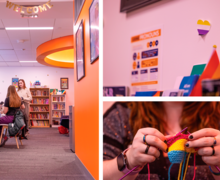VPA, architecture students share frustrations with out-of-pocket supply costs
Emma Lee | Contributing Illustrator
Syracuse University students in programs like architecture and design spend hundreds of dollars each semester on supplies for their class projects.
To support student journalism and the content you love, become a member of The Daily Orange today.
Last semester, Hannah Heald spent over $300 on printing. The junior communications design major, like many art students at Syracuse University, grapples with the out-of-pocket supply costs for her design classes.
“It’s really hard for me in particular, because with majors like ours, there isn’t really time for you to necessarily have a job,” Heald said. “So my money that I come with for the semester is for the semester. There’s no choice for me to have more. Having to spend money on outside of class supplies for my projects is taking away things like food.”
SU students in programs like architecture and design spend hundreds of dollars each semester on supplies for their class projects. The costs add up, and some students feel changes need to be made to better accommodate the expenses.
Heald works a summer job in order to pay for supplies during the school year. She spends another $150 per semester to get supplies for the products she creates in class. Her studio classes, such as painting and jewelry making, cost an additional $150 per semester.
Last semester, Heald had a project that required her to buy supplies in order to create and market her own version of a product. Heald chose to work with essential oils.
“I had to buy different bottles and I had to buy different packages, so that way I could learn how to build different unique ones for my products,” Heald said. “I know that mine was actually one of the cheaper (projects).”
The School of Art’s non-major specific supply list adds up to just under $250, with SU recommending students buy 30 items.
First-year architecture student Eric Ma said the museum board, a type of paperboard he has to buy for class projects, is much more expensive than he’s used to. In China, Ma only spent $1 on museum board. Now, it costs him $20.
“Because I’m from China, the prices are much lower than here in the United States,” Ma said. “It is a little bit expensive, but I can accept that because I need to.”

Megan Thompson | Digital Design Director
Henry Herbert, a first year architecture student, said he hasn’t had to face the full costs of his major yet.
“I’m a first-year so … I haven’t spent a lot of money, but I definitely see it adding up as semesters and years go on, especially as we get to more complicated, higher quality things and having to use higher quality materials,” Herbert said. “It’s going to be expensive.”
Both Herbert and Ma also purchased first-year architecture supply kits via the School of Architecture website, which are recommended but not required, at a “discounted rate” of $399. Ma said the kit has been “pretty useful” to him so far.
“It’s definitely a lot, a cost I wasn’t exactly expecting,” Herbert said. “I try to reframe it in my mind, I’m like ‘alright I’ve only had to buy one textbook, maybe (what) I’m spending on materials would have gone to textbooks.’”
Anastasia Powell, a junior communications design major, believes printing should be free for design students at SU. Given the school’s national design acclaim, Powell said she expects more resources to be available for design students at SU.
“$84,000 a year, you start to wonder where your tuition money goes after a while,” Powell said.
Powell said she applied for a Hendricks Chapel relief fund, but that it took months before she received a response. She was denied the $500 she requested to cover supply costs.
“With this major, I can see why somebody would want to transfer out because after a while, all of the funds add up and it gets ridiculous sometimes,” Powell said.
Powell said her professors have provided her with support and do their best to have an open dialogue with students about the financial ramifications of their projects.
“The professors are very caring, they try their best … we can go up to them and then we can figure something out with them in private,” she said. “It shouldn’t be the professor’s job to do it in the first place.”
Powell also said some students like herself have learned to take shortcuts to avoid costs. The quality of her projects doesn’t matter until the final week, so she often uses cheaper, lower-quality supplies for her prototypes.
Sam Willson, a first-year architecture student, said a pad with 20 sheets of bristol paper, a requirement for one of her assignments, cost $23.
Having to purchase supplies so frequently is “a pain”, Willson said, especially when the store doesn’t always have what she needs. Willson said she has left class before to purchase materials from the Schine Student Center when the store in Slocum Hall does not have them.
A sophomore in the School of Design, who wished to remain anonymous, said she spends roughly $350 per semester on supplies.
“I’m here on scholarship, so it’s a very big problem for me,” she said. “I have three different jobs, but on top of housing costs and everything else it’s been really hard because even if I tried to bargain with the school to try to get grants, it’s entirely unsuccessful and they’re just not willing to help at all.”
She also spends most of her money on printing, but said physical supplies like paper and rulers also add up, especially as a student on scholarship.
The semesterly studio art class she’s required to take makes up a large portion of supply costs because the materials tend to be very specific to that course and often cannot be reused.
In her photography studio class, she was unable to find any of the needed materials at Schine and instead had to order them online. But online prices are higher and supplies take longer to get, she said.
“The school does not make it easy for students who are here on scholarship to pay for supplies at all,” she said. “It reflects a bigger problem that SU tries to come off as inclusive and accessible, but it’s really not.”

Published on October 3, 2022 at 12:22 am
Contact Katie: ksmcclel@syr.edu | @katie_mcclellan





